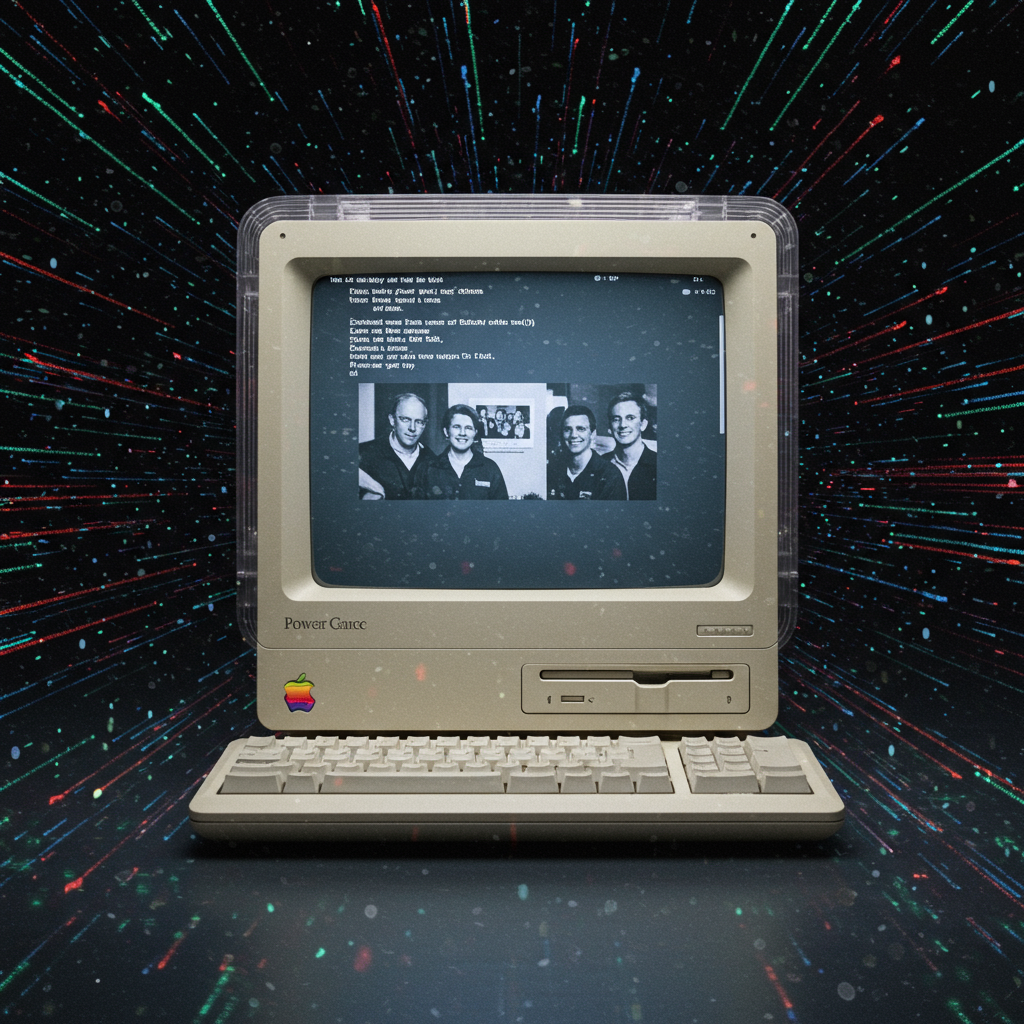Discovering digital secrets hidden within vintage technology offers a unique glimpse into computing history and the culture of past developers. A fascinating example recently emerged with the uncovering of a long-dormant easter egg tucked away in the Read-Only Memory (ROM) of Apple’s beige Power Mac G3 computers from the late 1990s. This hidden gem, an image of the software‘s development team, was known to ROM hackers but lacked a documented method for casual Mac users to find it within the standard Finder environment. This article explores the rediscovery, the simple technique required to access it, and the historical context of software secrets.
The journey to revealing this nearly three-decade-old secret was undertaken by Doug Brown, a self-described enthusiast of Apple, Linux, and Windows systems. Brown dedicated time to uncovering the activation method, driven by curiosity about undocumented features in classic Mac OS. While the existence of the “hidden dev team” image was already acknowledged in some technical circles aware of ROM hacking, the specific steps needed to make it appear as a discoverable file for typical users were a mystery. Brown’s goal was to bridge this gap, providing a user-friendly way to access this piece of Apple history.
Tracing the Digital Trail
Unearthing a secret buried in old software requires a combination of technical skill and detective work. Doug Brown employed software reverse engineering (SRE) tools to peer into the Power Mac G3’s ROM code. Among the tools utilized was Ghidra, a powerful SRE framework. By analyzing code sections, Brown began to piece together how the hidden image might be triggered.
His investigation led him to focus on the RAM disk driver. RAM disks were a feature in classic Mac OS that allowed users to allocate a portion of RAM to function as a temporary storage volume, offering faster read/write speeds than physical hard drives of the era. Decompiling the relevant code using Ghidra, Brown made a critical discovery: a specific process related to the RAM disk functionality was programmed to look for a particular text string. If this string matched, it would initiate the creation and writing of a hidden file. This pivotal string was identified as ‘secret ROM image’.
Unlocking the Secret: The Simple Method
Knowing the triggering string was a major breakthrough, but the exact sequence of user actions within the classic Mac OS environment still needed to be confirmed. Brown collaborated with Alex, another user from InfoSec Exchange. Together, they successfully tested the method and documented the steps.
The process is surprisingly straightforward once you know the specific trigger. It involves using the built-in Memory control panel in classic Mac OS to create a new RAM disk. After setting up the RAM disk, the computer must be restarted to ensure the new volume is properly mounted and appears on the desktop.
With the RAM disk visible, the key step involves formatting it. The user selects the RAM disk icon, navigates to the ‘Special’ menu in the Finder, and chooses ‘Erase Disk’. In the dialog box that appears asking for the new volume’s name, the user must enter the precise phrase ‘secret ROM image’. Typing this specific name acts as the command the ROM code is listening for.
The Hidden File Revealed
Upon successfully naming the RAM disk ‘secret ROM image’ and confirming the erase operation, a new file automatically appears at the root level of the newly created RAM disk volume. This file is named ‘The Team’. Examination reveals its file type is JPEG and its creator code is ttxt. The use of ‘ttxt’ as the creator code is significant; it indicates that the file is associated with SimpleText, the basic text editor included with classic Mac OS.
SimpleText, despite being a simple editor, possessed a hidden capability: it could render basic JPG images embedded within or associated with its files. Double-clicking the ‘The Team’ file in SimpleText opens the application, which then displays the hidden image. The image itself is a photograph of the 26-member development team responsible for the software containing this Easter egg, a digital signature left by the creators.
Experiencing the Past: Emulation Options
For those interested in seeing this vintage Easter egg but lacking the original beige Power Mac G3 hardware, there’s a convenient alternative. The method for accessing the ‘hidden dev team’ image also works within classic Mac OS emulators. Online emulators, such as the Infinite Macintosh, provide a readily accessible platform to recreate the experience.
Using an emulator, the steps are identical to those on physical hardware. Access the Memory control panel within the emulated classic Mac OS environment, set up a RAM disk, and restart the emulated system. Once the RAM disk appears on the emulated desktop, select it, choose ‘Erase Disk’ from the Special menu, and critically, name the volume ‘secret ROM image’. The ‘The Team’ file will then appear, ready to be opened by double-clicking, revealing the 27-year-old image.
The Era of Software Easter Eggs
The discovery of this Power Mac G3 Easter egg is a nostalgic reminder of a past era in software development. In the late 1990s and early 2000s, including hidden features, jokes, or tributes known as “Easter eggs” was a relatively common practice among programmers. These secrets were often accessed through obscure key combinations, menu sequences, or, as in this case, specific file or volume naming conventions.
Easter eggs were a way for developers to inject personality, showcase their team, or add elements of fun into their work. They served as inside jokes or rewards for adventurous users who might stumble upon them. This culture was widespread across different software platforms, from operating systems to productivity applications and video games.
However, the practice of including Easter eggs began to decline, particularly in large commercial software. At Apple, sources indicate that Steve Jobs discouraged their inclusion upon his return in 1997, favoring a more streamlined and polished user experience without hidden distractions. Microsoft also adopted a similar stance around 2002, reportedly implementing a “no-silly-nonsense policy” as part of its Trustworthy Computing Initiative, emphasizing security and reliability over playful hidden features.
While less prevalent in core operating systems and major business software today, some modern examples of Easter eggs still exist. The Surfing game accessible via ‘edge://surf’ in Microsoft Edge is a notable recent instance. Vintage software continues to harbor many undiscovered or forgotten secrets, making discoveries like the Power Mac G3 team image a rewarding aspect of digital archaeology and historical computing preservation.
Significance of the Discovery
Uncovering the user-friendly method for accessing this Power Mac G3 Easter egg is more than just a technical feat; it’s a small piece of computing history brought back into the light. It honors the developers who worked on these foundational systems and provides a tangible link to the culture and practices of software creation in the late 20th century. For enthusiasts of vintage Apple hardware and classic Mac OS, it offers a new, previously undocumented way to interact with their systems and appreciate the work that went into them.
The reliance on specific, seemingly arbitrary triggers like naming a RAM disk ‘secret ROM image’ highlights the unique ways developers embedded these secrets. It wasn’t always a simple “About” box trick. Sometimes, it required interacting with the system in an unexpected but precisely defined manner, making the discovery process a rewarding puzzle for those willing to delve deep. This finding encourages continued exploration of legacy systems, suggesting that other hidden gems might still await discovery.
Frequently Asked Questions
What is the Power Mac G3 Easter egg and who found it?
The Power Mac G3 Easter egg is a hidden image of the software’s development team, embedded in the Read-Only Memory (ROM) of beige Apple Power Mac G3 computers from the late 1990s. Its existence was known among ROM hackers, but the specific method for a typical user to access it in the Finder environment was undocumented until recently. The activation method was rediscovered and documented by Doug Brown, with help from Alex on InfoSec Exchange.
How can I see the Power Mac G3 Easter egg today, even without old hardware?
You can experience the Power Mac G3 Easter egg using classic Mac OS emulators. Online options like the Infinite Macintosh emulator support the necessary functionality. The process is the same as on physical hardware: use the Memory control panel to create a RAM disk, restart the emulated system, erase the RAM disk, and crucially, name it ‘secret ROM image’. This will make the ‘The Team’ image file appear, which you can open with SimpleText.
Why were Easter eggs common in old software like Classic Mac OS?
Including Easter eggs was a common practice in software development during the late 1990s. Developers often added hidden features, jokes, or team photos as a creative outlet, a way to personalize their work, or provide fun surprises for users. This practice became less common in major software as companies like Apple (post-1997) and Microsoft (post-2002) adopted policies prioritizing streamlined user experiences and security over hidden features.
Discoveries like the Power Mac G3 Easter egg underscore the rich history embedded within vintage software and hardware. They serve as digital artifacts, preserving not just the code itself, but also glimpses into the developer culture and the playful nature of computing’s past. The simplicity of the activation method, once known, contrasts with the complexity of the reverse engineering required to find it, highlighting the unique charm of these historical software secrets.
Word Count Check: ~1000 words




